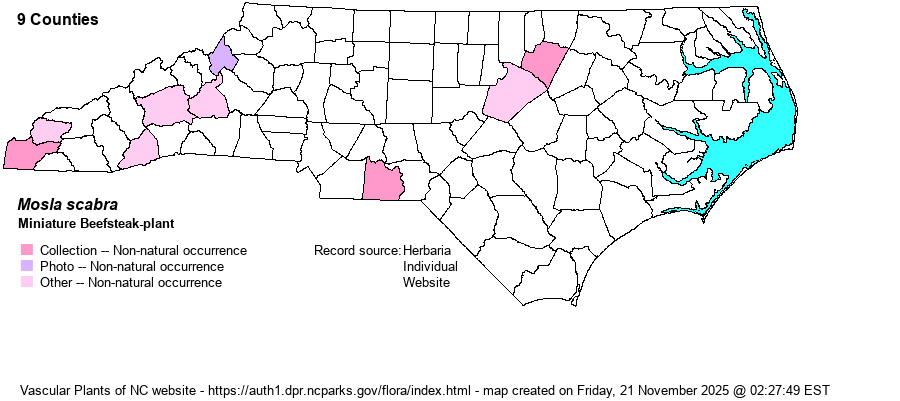| Author | (Thunb.) C.Y.Wu & H.W.Li | |
| Distribution | There is still some confusion whether all or nearly all of the NC records refer now (2025) to Mosla scabra or M. dianthera, if these are even both good entities. It appears (Sept 2025) that our records pertain to D. scabra and we will treat them as such until informed otherwise. Rapidly increasing/spreading in the western part of the state. There is a specimen from Cherokee County, Forest Service road 5 miles WNW of Murphy, 4 October 2011, Ed Schwartzman s.n. (NCU, WCUH). A second specimen was taken from Shocco Creek Gameland, Franklin County, 21 Sept 2021 by McCormick and Peifer (NCU accession 701549). There are now recent -- 2020 and later -- photo records on iNaturalist from Transylvania, McDowell, Anson, and Wake counties; plus a photo record for Avery County in 2022. A sight report was made in Buncombe County in 2024.
Native to Eastern Asia; in N.A. IN, KY, TN, AL, GA, NC. | |
| Abundance | Apparently rare, but Weakley (2018) states that it is becoming a noxious weed in KY, TN, and western NC. | |
| Habitat | Margin of US Forest Service road, other disturbed ground. | |
| Phenology | Flowering and fruiting August-September. | |
| Identification | This mint is about 1-3 feet tall, with well-spaced, lance-shaped to ovate paired leaves. The inflorescences arise terminally and from upper leaf axils; they are slender and hold many flowers. The upper calyx lobes are curved a bit upwards; the lower ones are straight. The corollas are small, tubular and with the lower lip rather downcurved, pale pink in color. | |
| Taxonomic Comments | See above. Neither NatureServe nor iNaturalist recognize M. dianthera at all, but they do for M. scabra. At any rate, it appears that nearly all of the NC records refer to the same taxon.
| |
| Other Common Name(s) | | |
| State Rank | SE | |
| Global Rank | GNR | |
| State Status | | |
| US Status | | |
| USACE-agcp | | |
| USACE-emp | | |

